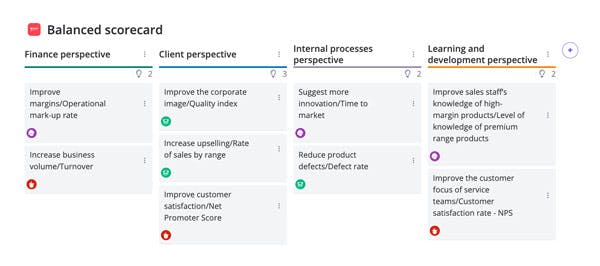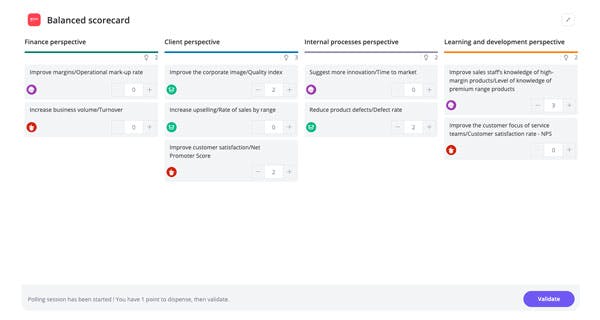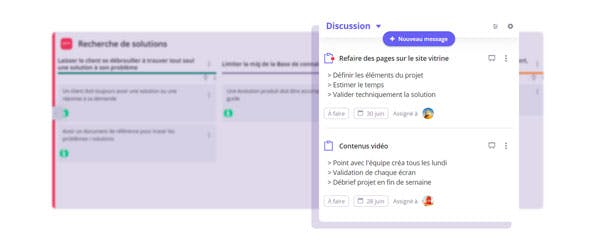Balanced Scorecard
The Balanced Scorecard tool, developed by Kaplan and Norton, marked a mini-revolution in the way a company’s key indicators are set for at least two reasons.
First, it’s balanced between financial and non-financial indicators.
Second, it’s forward-looking. As such, it focuses on factors that drive future performance rather than on the purely financial side, which represents yesterday’s achievements.
You can use it once the company’s strategy has been set. It gives you the means to find the right levers for successful implementation.
A balanced scorecard addresses 4 perspectives:
- Finances
- Clients
- Internal processes
- Learning and development
For each of these, you’ll use a previously defined strategy to set objectives and the associated performance indicators.
Each participant will then share their views on these different perspectives in order to generate a specific list of objectives and associated indicators that will enable you to steer your corporate strategy.
Pre-requisites
This activity should be tackled with a team that has visibility of at least one of the key aspects of the company’s business. A minimum of one person representing sales, marketing, production and/or service, finance and human resources should attend. Prepare a Board in round by round mode, with 4 categories corresponding to the 4 perspectives (Finances, Clients, Internal Processes, Learning and Development).
Activity settings Board
- Activity format: Round by round
- Vote: in Points
- Time management: Timer (30-60 min)
- Categories: 4 activity categories
Process
Presentation
Specify the purpose of the meeting: Today you will work with the group to refine the company’s strategic objectives and set the associated performance indicators. Introduce the activity and the meaning of each of the four categories:
- Finance perspective: What financial targets are tied to our strategy? What are the associated financial indicators? To fully embrace this perspective, you’ll have to take the position of a company shareholder/investor. Say a company wants to improve their financial viability. In that case, the indicator would be mark-up rates, which the company wants to increase to 25% as a target.
- Client perspective: What changes are needed in the way we interact with or project our image to clients? In this case, you’re taking on the client’s point of view. What needs to change at their level to enable our strategy to succeed? To continue our example, improving profitability may involve a different product mix for clients, who’d see higher margin products promoted over those with lower margins. This might require improving the company’s branding so that customers are more attracted to these higher added-value products. This time, the indicator would be the brand image measured in terms of perceived quality or customer satisfaction.
- Internal processes perspective: In what fields should we be excelling? This internal perspective must focus on the processes that will contribute most to the strategy. In our example, profitability could be improved by reducing the number of customer complaints, which generate additional operational costs and damage the image in terms of quality. Thus, the indicator would be the defect rate for products.
- Learning and development perspective: The aim here is to highlight the company’s human and organisational sides, which will also contribute to the strategy’s success. The indicators sought will cover skills to be improved as well as the collective capacity of the organisation to improve and change. Continuing to use our example, a good indicator might be the percentage of salespeople fully familiar with the products that contribute most to the company’s margins.
For each perspective, you may want to give a few examples of indicators so that all participants understand the template’s 4 aspects.

Exploration
Each participant works quietly on their own during the time allocated for exploration, taking note of their objectives – and the associated indicator for each – on their Beekast notepad for each of the 4 perspectives. Thus, each suggestion will have to include an objective and its associated indicator. This will help avoid objectives that are too vague or unmeasurable.
It’s important for the exploration phase to be done in silence to avoid any influence from the group.
Discussion
One by one, the participants send their notepad ideas to the Board, taking a few seconds to explain each idea.
Make sure that each idea is assigned to the right perspective: while there is little risk of error for financial targets and indicators, it’s more likely for other perspectives. You can create groups as you go along to put similar or identical ideas together. You can also use colour markers. During the discussion, feel free to create a new idea that revisits an objective but changes the indicator, after talking it over.

Selection
Your idea gathering session is finished once everyone has had a chance to speak. If there are a lot of ideas to discuss, we recommend casting votes using points:
- You can switch directly to the voting session in your Beekast Board. Remind participants that they only have a few points, in order to prioritise what really matters to them. Ask them to choose at least one idea per perspective. We recommend giving each participant 10 points to allow these choices.

Summary
Once the vote is over or you’ve made your manual selections, identify the ideas with the most votes (usually the first 2 or 3 for each perspective) to make your strategic balanced scorecard official. Straight after, you can set up an action plan to kickstart the dynamic associated with the new strategy.
You can create the actions using the ideas on the Board or directly in the discussion space so that they’ll show up in your meeting notes.

Suggestions and variations
Ideally, you’d run through an icebreaker activity to get people talking.
You’ll have to have framed the strategy ahead of time. To do this, you can use the SWOT Matrix to assess the situation, followed up with tools like Ansoff Matrix, the Innovation Matrix or even the 3 Horizons.
These templates may interest you

SCAMPER Method

Reverse Brainstorming

 Beekast
Beekast